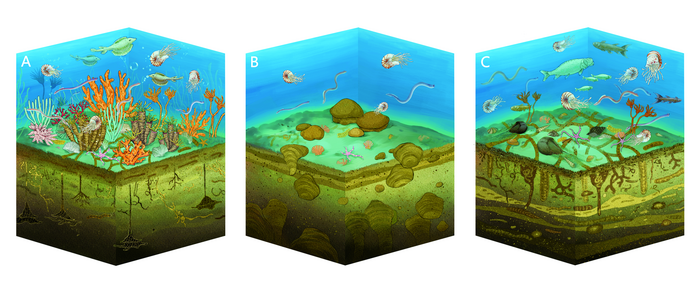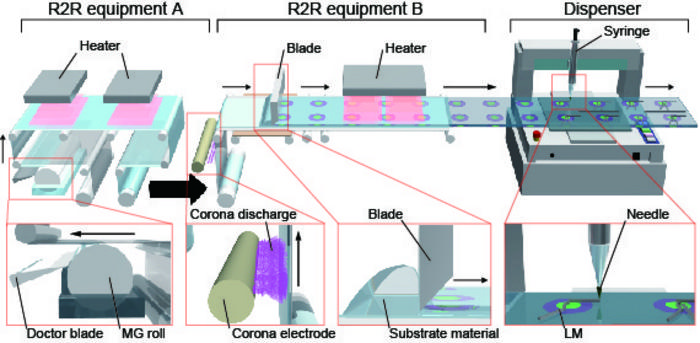Researchers studying ancient sea bed burrows and trails have discovered that bottom burrowing animals were among the first to bounce back after the end-Permian mass extinction.

Credit: By artist Yaqi Jiang (A, Permian, B, Early Triassic Griesbachian, C, Early Triassic Smithian)
Researchers studying ancient sea bed burrows and trails have discovered that bottom burrowing animals were among the first to bounce back after the end-Permian mass extinction.
In a new study, published today in the journal Science Advances, researchers from China, the USA and the UK, reveal how life in the sea recovered from the event, which killed over 90 percent of species on Earth, from their observations of trace fossils.
Life was devastated by the end-Permian mass extinction 252 million years ago, and recovery of life on Earth took millions of years for biodiversity to return to pre-extinction levels. But by examining trails and burrows on the South China sea bed, the international team were able to piece together sea life’s revival by pinpointing what animal activity was happening when.
Professor Michael Benton from the University of Bristol’s School of Earth Sciences, a collaborator on the new paper, said: “The end-Permian mass extinction and the recovery of life in the Early Triassic are very well documented throughout South China.
“We were able to look at trace fossils from 26 sections through the entire series of events, representing seven million crucial years of time, and showing details at 400 sampling points, we finally reconstructed the recovery stages of all animals including benthos, nekton, as well as these soft-bodied burrowing animals in the ocean.”
Dr Xueqian Feng from the China University of Geosciences in Wuhan led the study, and his focus was on ancient burrows and trails. He explained: “Trace fossils such as trails and burrows document mostly soft-bodied animals in the sea. Most of these soft-bodied animals had no or poor skeletons.
“There are some amazing localities in South China where we find huge numbers of beautifully preserved trace fossils, and the details can show infaunal ecosystem engineering behaviours, as well as their feedback effects on biodiversity of skeletonized animals.”
Professor Zhong-Qiang Chen, director of the study, said: “The trace fossils show us when and where soft-bodied, burrowing animals flourished in this Early Triassic greenhouse world.
“For example, elevated temperatures and extended anoxia coincided with low values of behavioural and ecologic diversities across the Permian-Triassic boundary, and it took about 3 million years for ecological recovery of soft-bodied animals to match the pre-extinction levels.”
Professor David Bottjer, a collaborator in the study from the University of Southern California, added: “One of the most remarkable aspects of the South China data is the breadth of ancient environments we could sample.
“Differential responses of infaunal ecosystems to variable environmental controls may have played a significant but heretofore little appreciated evolutionary and ecologic role in the recovery in the hot Early Triassic ocean.”
Dr Chunmei Su, another collaborator, said: “The mass extinction killed over 90 percent of species on Earth, and we see that in the catastrophic reduction in ecological function of the surviving animals in the ocean.
“At first, there were only a few survivors, and recovery began in deeper waters. The recovery of nekton occurred at the same time as the full rebound of infaunal ecosystem engineering activities.”
Alison Cribb, a collaborator in the study from the University of Southern California, added: “The first animals to recover were deposit feeders such as worms and shrimps. The recovery of suspension feeders such as brachiopods, bryozoans and many bivalves took much longer.
“Maybe the deposit feeders were making such a mess of the seafloor that the water was polluted with mud, the churned mud meant suspension feeders could not properly settle on the seafloor, or the muddy water produced by those deposit feeders just clogged the filtering structures of suspension feeders and prohibited them from feeding efficiently.”
Professor Chen added: “And some animals, such as corals, had disappeared completely. Coral reefs did not return until much later.”
Dr Feng concludes: “Why does it matter to understand these great mass extinctions of the geological past?
“The answer is that the end-Permian crisis – which was so devastating to life on Earth – was caused by global warming and ocean acidification, but trace-making animals may be selected against by the environment in a way that skeletal organisms were not.
“Our trace fossil data reveals soft-bodied animals’ resilience to high CO2 and warming. These ecosystem engineers may have played a role in benthic ecosystem recovery after severe mass extinctions, potentially, for example, triggering the evolutionary innovations and radiations in the Early Triassic.”
Paper:
‘Resilience of infaunal ecosystems during the Early Triassic greenhouse Earth’ by Xueqian Feng, Zhong-Qiang Chen, Michael J. Benton, Chunmei Su, David J. Bottjer, Alison T. Cribb, Ziheng Li, Laishi Zhao, Guangyou Zhu, Yuangeng Huang, and Zhen Guo in Science Advances
Journal
Science Advances
Method of Research
Observational study
Subject of Research
Animals
Article Title
Resilience of infaunal ecosystems during the Early Triassic greenhouse Earth
Article Publication Date
29-Jun-2022





